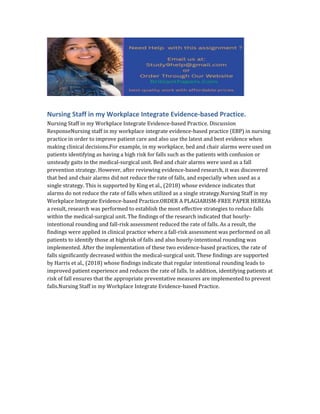Nursing Staff in my Workplace Integrate.docx
•Download as DOCX, PDF•
0 likes•2 views
course material
Report
Share
Report
Share

Recommended
More Related Content
Similar to Nursing Staff in my Workplace Integrate.docx
Similar to Nursing Staff in my Workplace Integrate.docx (15)
Essentials of Evidence Based PracticeMAIN POSTIntroduction.docx

Essentials of Evidence Based PracticeMAIN POSTIntroduction.docx
January-February 2016 • Vol. 25No. 1 17CPT (R) Gwendolyn .docx

January-February 2016 • Vol. 25No. 1 17CPT (R) Gwendolyn .docx
ROUND WITH A PURPOSE PURPOSEFUL HOURLY ROUNDING AND THE IMP.docx

ROUND WITH A PURPOSE PURPOSEFUL HOURLY ROUNDING AND THE IMP.docx
ROUND WITH A PURPOSE PURPOSEFUL HOURLY ROUNDING AND THE IMP.docx

ROUND WITH A PURPOSE PURPOSEFUL HOURLY ROUNDING AND THE IMP.docx
Evidence_based_practice_obstetrics_gynaecology_Kabra_2008.pdf

Evidence_based_practice_obstetrics_gynaecology_Kabra_2008.pdf
J Wound Ostomy Continence Nurs. 2015;42(2)151-154.Published.docx

J Wound Ostomy Continence Nurs. 2015;42(2)151-154.Published.docx
ISBARR The purpose of this project is to practice formulat

ISBARR The purpose of this project is to practice formulat
ISBARR The purpose of this project is to practice formulat.docx

ISBARR The purpose of this project is to practice formulat.docx
ISBARR The purpose of this project is to practice formulat.docx

ISBARR The purpose of this project is to practice formulat.docx
More from 4934bk
More from 4934bk (20)
You are the information technology manager of an.docx

You are the information technology manager of an.docx
Write about interactions in the premodern world.docx

Write about interactions in the premodern world.docx
Why are the ancient legends of China of interest to.docx

Why are the ancient legends of China of interest to.docx
Why did the Roman Catholic Church consider the sin of.docx

Why did the Roman Catholic Church consider the sin of.docx
What similarities do you notice between organizations for the.docx

What similarities do you notice between organizations for the.docx
Who invented the printing and how did it have an.docx

Who invented the printing and how did it have an.docx
Which is the true statement regarding the criteria for prioritizing.docx

Which is the true statement regarding the criteria for prioritizing.docx
What was the threat posed to western style democracy in.docx

What was the threat posed to western style democracy in.docx
What stereotypes did Catholics have of Protestants and Protestants of.docx

What stereotypes did Catholics have of Protestants and Protestants of.docx
Recently uploaded
Making communications land - Are they received and understood as intended? we...

Making communications land - Are they received and understood as intended? we...Association for Project Management
Recently uploaded (20)
Russian Escort Service in Delhi 11k Hotel Foreigner Russian Call Girls in Delhi

Russian Escort Service in Delhi 11k Hotel Foreigner Russian Call Girls in Delhi
ICT Role in 21st Century Education & its Challenges.pptx

ICT Role in 21st Century Education & its Challenges.pptx
Unit-V; Pricing (Pharma Marketing Management).pptx

Unit-V; Pricing (Pharma Marketing Management).pptx
ICT role in 21st century education and it's challenges.

ICT role in 21st century education and it's challenges.
Making communications land - Are they received and understood as intended? we...

Making communications land - Are they received and understood as intended? we...
Unit-IV; Professional Sales Representative (PSR).pptx

Unit-IV; Professional Sales Representative (PSR).pptx
Kodo Millet PPT made by Ghanshyam bairwa college of Agriculture kumher bhara...

Kodo Millet PPT made by Ghanshyam bairwa college of Agriculture kumher bhara...
This PowerPoint helps students to consider the concept of infinity.

This PowerPoint helps students to consider the concept of infinity.
Nursing Staff in my Workplace Integrate.docx
- 1. Nursing Staff in my Workplace Integrate Evidence-based Practice. Nursing Staff in my Workplace Integrate Evidence-based Practice. Discussion ResponseNursing staff in my workplace integrate evidence-based practice (EBP) in nursing practice in order to improve patient care and also use the latest and best evidence when making clinical decisions.For example, in my workplace, bed and chair alarms were used on patients identifying as having a high risk for falls such as the patients with confusion or unsteady gaits in the medical-surgical unit. Bed and chair alarms were used as a fall prevention strategy. However, after reviewing evidence-based research, it was discovered that bed and chair alarms did not reduce the rate of falls, and especially when used as a single strategy. This is supported by King et al., (2018) whose evidence indicates that alarms do not reduce the rate of falls when utilized as a single strategy.Nursing Staff in my Workplace Integrate Evidence-based Practice.ORDER A PLAGIARISM-FREE PAPER HEREAs a result, research was performed to establish the most effective strategies to reduce falls within the medical-surgical unit. The findings of the research indicated that hourly- intentional rounding and fall-risk assessment reduced the rate of falls. As a result, the findings were applied in clinical practice where a fall-risk assessment was performed on all patients to identify those at highrisk of falls and also hourly-intentional rounding was implemented. After the implementation of these two evidence-based practices, the rate of falls significantly decreased within the medical-surgical unit. These findings are supported by Harris et al., (2018) whose findings indicate that regular intentional rounding leads to improved patient experience and reduces the rate of falls. In addition, identifying patients at risk of fall ensures that the appropriate preventative measures are implemented to prevent falls.Nursing Staff in my Workplace Integrate Evidence-based Practice.